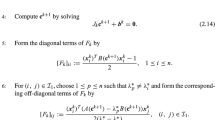Summary
The spectral-transform method for solving nonlinear evolution equations is extended to certain classes of matrix equations with linearlyx-dependent coefficients and the existence of the conservation laws for the new class of nonlinear evolution equations is investigated. A remarkably explicit representation is, moreover, obtained for the conserved quantities of the «old» classes of nonlinear evolution equations (withx-independent coefficients).
Riassunto
In questo lavoro il metodo della trasformata spettrale per risolvere equazioni di evoluzione non lineari è stato esteso a certe equazioni matriciali nelle quali compare una dipendenza lineare esplicita dalla variabile spazialex; si è studiata anche l'esistenza di leggi di conservazione associate alla nuova classe di equazioni di evoluzione non lineari. Nel processo di derivazione di tali leggi, si è ottenuta una rappresentazione esplicita notevole per le quantità conservate della «vecchia» classe di equazioni di evoluzione non lineari (cioè quelle in cui non c'è la dipendenza esplicita dalla variabile spazialex).
Резюме
Метод спектральных преобразований для решения нелинейного уранвнеия эволюции обобщается на некоторые классы матричного уравнения с коэффициентами, зависящими линейно отx. Исследуется существование законов сохранения для нового класса нелинейного уравнения эволюции. Кроме того, получается явное представление для сохраняющихся величин «старых» классов нелинейного уравнения эволюции (с коэффициентами, не зависящими отx).
Similar content being viewed by others
References
M. Wadati andT. Kamijo:Prog. Theor. Phys.,52, 397 (1974).
F. Calogero andA. Degasperis:Nuovo Cimento B,39, 1 (1977).
F. Calogero andA. Degasperis:Nuovo Cimento B,32, 1 (1976).
F. Calogero andA. Degasperis:Lett. Nuovo Cimento,22, 131 (1978).
F. Calogero andA. Degasperis:Lett. Nuovo Cimento,22, 138 (1978).
F. Calogero andA. Degasperis:Commun. Math. Phys.,63, 155 (1978).
L. Pilloni:Una nuova classe di equazioni di evoluzione non lineari risolubili mediante il metodo della trasformata spettrale, Istituto di Fisica dell'Università degli Studi, Roma, 29 Novembre 1978. (Graduation Thesis.)
f x (x)≡(d/dx)f(x).
We suppose that\(\mathop {\lim }\limits_{\left| x \right| \to \infty } Q(x)\) exp [|x|ε] (ε>0), because in this cause the reflection coefficient is meromorphic in the whole upper half of the complexk-plane and can be analytically continued in thek-variable. Moreover, in this case the poles ofR(k) occur just at the discrete eigenvaluesk (n) and the residues ofR(k) are related to the corresponding vectorsc (n) by formula (2.2.10).
I. M. Gel'fand andB. M. Levitan:Am. Math. Soc. Transl.,1, 253 (1955);Z. S. Agranovich andV. D. Marchenko:The Inverse Problem of Scattering Theory (New York, N. Y., 1963).
F. Calogero:Generalized Wronskyans relations: a novel approach to Bargman-equivalent and phase-equivalent potentials, inStudies in Mathematical Physics, edited byE. H. Lieb, B. Simon andA. S. Wightman (Princeton, N. J., 1976).
F. Calogero:Nuovo Cimento B,31, 229 (1976).
This relation can be found in ref. (2) even if it is not written so explicitly.
In our graduation thesis (7)L. Pilloni:Una nuova classe di equazioni di evoluzione non lineari risolubili mediante il metodo della trasformata spettrale, Istituto di Fisica dell'Università degli Studi, Roma, 29 Novembre 1978. (Graduation Thesis.) we have discussed in detail the case ofN×N matrices withh(z, t) depending linearly on thez-variable (namelyh(z, t)=h 0 (t)+zh 1 (t)).
Note thatnow the quantitiesα n σ n andβ n σ n appearing in (3.2.4) indicate, respectively,\(\mathop \Sigma \limits_n \alpha _n \sigma _n \) and\(\mathop \Sigma \limits_n \beta _n \sigma _n \).
Throughout this paper we use the notation\(v = v\hat v\), wherev is a generic 3-vector,v is its modulus and\(\hat v\) is a unit vector.
The system related to the boomeron equation is the following:\(\xi _t (t) = - (b).\hat n(t)),\hat n(t) = 2p[(b.\hat n(t))\hat n(t) - b] + a \wedge \hat n(t)\). (Of course, nowp is constant.) For a more detailed analysis see ref. (18).
F. Calogero andA. Degasperis:Lett. Nuovo Cimento,16, 425 (1976).
This property of the transmission coefficientT(k) can be found in ref. (1).
Author information
Authors and Affiliations
Additional information
Переведено редакцией.
Rights and permissions
About this article
Cite this article
Pilloni, L. Extension of the spectral-transform method for solving nonlinear evolution equations and related conservation laws. Nuov Cim B 56, 87–109 (1980). https://doi.org/10.1007/BF02738360
Received:
Revised:
Published:
Issue Date:
DOI: https://doi.org/10.1007/BF02738360




